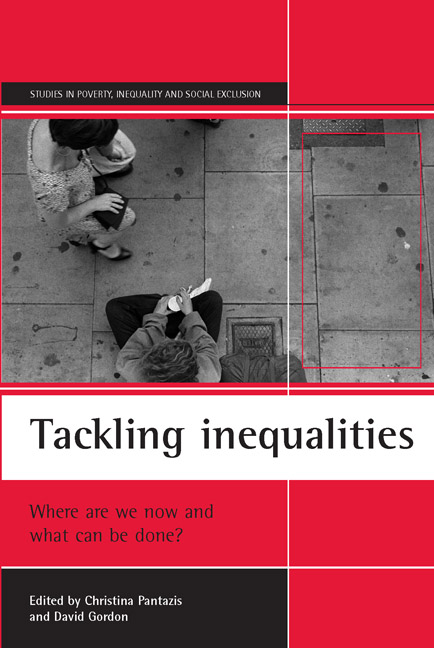Book contents
- Frontmatter
- Contents
- List of tables and figures
- Preface
- Acknowledgements
- List of acronyms
- Notes on contributors
- 1 Introduction
- 2 Inequalities in income, wealth and standard of living in Britain
- 3 Inequalities in employment: problems of spatial divergence
- 4 Educational inequalities and Education Action Zones
- 5 How can we end inequalities in housing?
- 6 Tackling inequalities in crime and social harm
- 7 Poverty across the life-course and health
- 8 Inequalities in health service provision: how research findings are ignored
- 9 A mortality league table for Cabinet ministers?
- 10 Ending world poverty in the 21st century
- Index
1 - Introduction
Published online by Cambridge University Press: 05 July 2022
- Frontmatter
- Contents
- List of tables and figures
- Preface
- Acknowledgements
- List of acronyms
- Notes on contributors
- 1 Introduction
- 2 Inequalities in income, wealth and standard of living in Britain
- 3 Inequalities in employment: problems of spatial divergence
- 4 Educational inequalities and Education Action Zones
- 5 How can we end inequalities in housing?
- 6 Tackling inequalities in crime and social harm
- 7 Poverty across the life-course and health
- 8 Inequalities in health service provision: how research findings are ignored
- 9 A mortality league table for Cabinet ministers?
- 10 Ending world poverty in the 21st century
- Index
Summary
The growing divide between the poor and the rich is probably the most significant social change to have occurred under 18 years of Conservative government. The New Labour government inherited a country more unequal than at any other time since the Second World War (Barclay, 1995; Hills, 1995; 1998a; see also Chapter Two). There are now wider gaps in income inequality between different family types, different economic status groups, different housing tenures, and between different regions (Goodman et al, 1997; Hills, 1998a). People on benefits such as the unemployed, lone parents, and pensioners, are overrepresented in the bottom income distribution, as are children because of their disproportionate representation in households where there are fewer earners. Compared with other European countries, the United Kingdom (UK) now has the highest proportion of children living in households where income is below half that of the average (Eurostat, 1997) – or what is generally considered as the best proxy for an official poverty line.
Despite the overall growth in incomes under the previous Conservative governments, rates of growth were not shared equally throughout the population. The Households Below Average Income (HBAI) statistics demonstrate that whereas the income of the richest 10% of the population grew from 60% to 68% between 1979 and 1994/95, the income of the poorest group grew by only 10% (before housing costs) or fell by 8% if calculated after housing costs (Hills, 1998a). Some groups – including children – have become worse off in absolute terms (Bradshaw, 1999; see also Chapter Two). These differing fortunes have resulted in a significant change in the overall share of total income. Throughout the 1960s, 1970s and early 1980s, the poorer half of the population had roughly one third of total income (after housing costs), while the richest 10% had about one fifth. By 1996 the richest 10% controlled 28% of the total income, while the whole of the poorer half of the population had only one quarter of total income (see Chapter Two).
This book brings together a collection of contributions on the pressing issue of tackling inequalities in society. Many of the chapters chart the extent of social inequalities inherited by the New Labour government, and offer a critique of the government's policies aimed at tackling those inequalities.
- Type
- Chapter
- Information
- Tackling InequalitiesWhere Are We Now and What Can Be Done?, pp. 1 - 24Publisher: Bristol University PressPrint publication year: 2000



